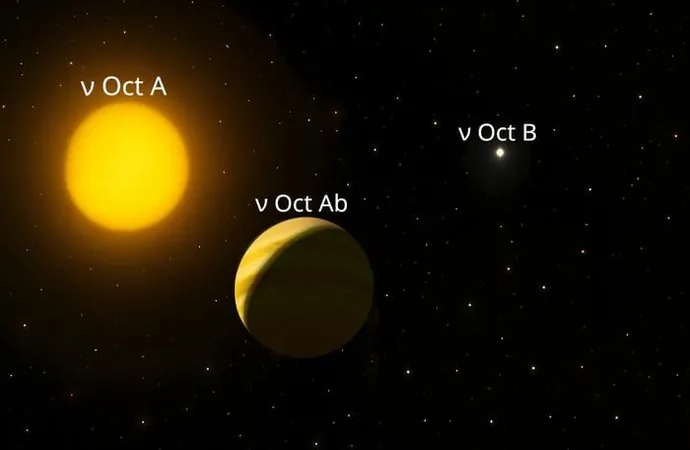
Unlocking the Secrets of Planet Formation in Binary Star Systems
2025-08-30
Author: Li
Revealing the Mysteries of Binary Stars and Their Planets
What can we learn about planet formation from binary star systems? A groundbreaking study published in *Nature* dives deep into this question, examining how a unique binary system might host a planet with a retrograde orbit—one that moves opposite to its star’s rotation. This research opens new avenues in understanding how planets form and evolve in these complex stellar environments, shedding light on the potential for life beyond Earth.
Unveiling the Nu Octantis System
The focus of this fascinating study is nu Octantis (nu Oct), a binary star system located about 73.5 light-years from Earth. This system is made up of two stars: a K-type star, nu Oct A, which is 1.5 times the mass of our Sun, and a smaller companion, nu Oct B, weighing in at half the solar mass. The intriguing planet orbiting nu Oct A—dubbed nu Oct A b—has a mass around 2.19 times that of Jupiter and resides approximately 1.24 astronomical units from its star, completing its orbit in about 402 days.
The Surprising Retrograde Orbit
Utilizing the European Southern Observatory’s HARPS spectrograph, researchers have confirmed that nu Oct A b indeed has a retrograde orbit. This finding is significant because it challenges our understanding of how planets can exist in binary systems. The smaller star, nu Oct B, was found to be a white dwarf, a dense remnant of a once-massive star, reminiscent of what our Sun will eventually become.
A Glimpse into Stellar History
Lead author Ho Wan Cheng from The University of Hong Kong reveals that the system is about 2.9 billion years old. Nu Oct B originally had 2.4 times the mass of our Sun before evolving into a white dwarf approximately 2 billion years ago. This historical context provides invaluable insights into the conditions under which nu Oct A b formed.
Two Theories of Planet Formation
The researchers propose two intriguing scenarios for how nu Oct A b could have come into existence: 1. **Formed from Debris:** The planet may have been born from a debris disk generated when nu Oct B transformed into a white dwarf. 2. **Captured by Gravity:** Alternatively, nu Oct A b might have started with a normal, prograde orbit before being captured by the gravitational pull of nu Oct A.
The Quest to Understand Exoplanets
What sets nu Oct A b apart is its retrograde orbit. While Venus and Uranus in our own solar system display backward rotations, they maintain prograde orbits. This unique characteristic of nu Oct A b offers a fresh perspective on the formation mechanisms of exoplanets, particularly those in binary or multiple star systems.
The Future of Binary Star Research
As we look to the future, what remarkable discoveries await researchers studying binary star systems and planetary evolution? With our closest multiple star system, Alpha Centauri, harboring an unconfirmed rocky planet with a prograde orbit, the stage is set for more surprises. Currently, only two exoplanets—HAT-P-7b and WASP-17b—are known to have retrograde orbits, making nu Oct A b a critical piece in the puzzle of planetary science.
As always, this thrilling pursuit of knowledge reminds us to keep looking up and exploring the wonders of the universe.
 Brasil (PT)
Brasil (PT)
 Canada (EN)
Canada (EN)
 Chile (ES)
Chile (ES)
 Česko (CS)
Česko (CS)
 대한민국 (KO)
대한민국 (KO)
 España (ES)
España (ES)
 France (FR)
France (FR)
 Hong Kong (EN)
Hong Kong (EN)
 Italia (IT)
Italia (IT)
 日本 (JA)
日本 (JA)
 Magyarország (HU)
Magyarország (HU)
 Norge (NO)
Norge (NO)
 Polska (PL)
Polska (PL)
 Schweiz (DE)
Schweiz (DE)
 Singapore (EN)
Singapore (EN)
 Sverige (SV)
Sverige (SV)
 Suomi (FI)
Suomi (FI)
 Türkiye (TR)
Türkiye (TR)
 الإمارات العربية المتحدة (AR)
الإمارات العربية المتحدة (AR)